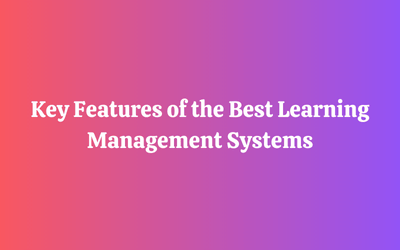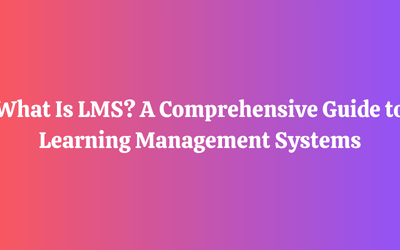Learning Experience Platform VS Learning Management System
Businesses have been left with several excruciating questions ever since the term Learning Experience Platform (LXP) entered the L&D zeitgeist four years ago. Should my Learning Management System (LMS) be replaced by an LXP? Do LXPs live up to the hype? My LMS and LXP—can they coexist? Should I be looking in other places instead?
As LXPs first gained notoriety in 2018–19, several firms decided on the path of their learning platforms. But the situation has changed. Issues that have been accumulating over the previous few years have been accelerated and brought to light by COVID-19. Companies now have a greater understanding of the massive reskilling and upskilling responsibilities that lie ahead of them. More than ever, learners are motivated to advance their knowledge. The relative values that LXPs and LMSs can offer have changed as a result.
Additionally, the platforms themselves have evolved. Because various goods cater to various pain areas, all of them have incorporated new features and the markets have changed. This comprehensive guide is designed to assist companies in determining what they require from their LMS or LXP in the uncertain year of 2021.
Always remember to use these definitions with caution. There is no absolute separation. Within their respective categories, LXPs and LMSs differ from one another. Some LMSs will assert that they have LXP features, and vice versa. This essay is based on the common distinctions you’ll see in real-world scenarios and how these systems are typically employed within businesses.
Once that is sorted, below are the important considerations you need to make when choosing the learning platform(s) you require or must maintain.
What distinguishes a learning management system from a platform for learning experiences?
Administrators can assign and monitor highly structured training content using an LMS. On the other hand, an LXP is a platform that focuses on the user and allows them to select their learning from a wide range of tailored information. An LXP visits YouTube in the same way that an LMS visits a movie theatre.
Who holds the reins?
The power balance is the key distinction between LMSs and LXPs. It’s fairly easy in LMSs. Each user’s content viewing experience and what they must learn are under the authority of Learning & Development.
Users in LXPs decide what they wish to consume. This is typically done through browsing or searching, depending on the platform. LXPs are configured with “trays” of categorized content that the user may browse through, similar to the majority of streaming services. They also feature effective search capabilities.
On LXPs, users are responsible for their learning, but the platforms typically offer assistance. Personalization is basically where this comes from. LXPs attempt to select material that is pertinent to the user or company objectives because there is a lot of content available (with varying success).
The process of getting content onto an LXP is likewise more democratic. L&D typically uploads fairly formal and structured content to an LMS (the majority of the time it’s compliance training). On an LXP, users have more influence over the content that is provided, including the ability to curate outside content for other users, produce their content, compile content into learning paths, and manage their digital learning sessions.
Businesses that seek to promote self-driven learning, a requirement for the development of agile and flexible abilities, must take into account this democracy. Based on your sector, the firm may be eager to support this in 2021.
With an LMS, administrators assign users to train; in an LXP, users select their learning within a framework established by the enterprise.
Who learns from users?
The LMS and LXP are designed for many forms of learning. The prescriptiveness of a learning management system is higher. The students will log in and complete the prescribed courses, which frequently have exams at the conclusion. The content will likely be fairly diverse and frequently company- or department-wide. Instead of “growing your knowledge and opportunities,” the LMS’s goal is more about “coming up to speed.”
It might lack some glitz, but this is still necessary for the majority of businesses. It’s also a happy environment for learning management systems. They are reliable, clear, and trackable so that students may quickly pick up what they need and resume working.
Users and material are matched by LMSs, with compliance content in particular. In most firms, this is crucial to keep users abreast of evolving legislation, and an LXP is overkill in this situation.
The LXP, on the other hand, is designed for personal development rather than box-ticking. There is a wide range of content that is readily available that is intended to help learners become better at their occupations or more suitable for them. Too much, at times.
LXPs must have robust search capabilities, personalized suggestions, a variety of content kinds, and an intuitive interface for this to perform at the organizational level. Since many of the types of content that LXPs host are incompatible with LMSs, LMSs are unable to handle that level of versatility.
On a Learning Experience Platform, the content is typically less directive. It frequently lacks a clear endpoint and is harder to quantify. It seeks to develop abilities naturally. While larger courses and content playlists are available in LXPs, a more complete learning environment also includes a lot of microlearning and thinking pieces.
TL;DR: Users who use an LMS receive instruction in compliance, regulations, and general theory. Users of an LXP select from a wide variety of learning to enhance their performance at work or themselves.
What kinds of content are hosted by the two systems?
Longer-form content in a preset structure is typically hosted by LMSs. It might be used, for instance, to assign new hires to induction training programs so that progress can be monitored and learning retention can be evaluated in a graded test. The training is typically regulated or required.
Due to SCORM, the training’s format and style are extremely rigorous (Shareable Content Object Reference Model). All LMS content is required to adhere to a set of standards and guidelines established by SCORM, just like a key needs to have a specific form to fit into a lock.
The LXP’s doors have been unlocked. LXPs can host practically any form of content you throw at them with minimum effort thanks to xAPI (or equivalents). So, students can read content created by employees or articles from websites, or they can take quizzes, view films, or participate in webinars. You’ll see that the LXP’s versatility is a recurring theme.
TL;DR: LMSs host highly particular content categories that emphasize compliance. LXPs can host almost anything.
How are the data used by them?
Data will be tracked by an LMS. Still, it’s typically fairly simple. KPIs include drop-off rates, assessment results, and whether learners finished training programs. Even if there is a lot more data to gather, you wouldn’t anticipate it as standard with a typical learning management system. Their actual expertise, as previously mentioned, lies in aligning staff with the compliance and regulatory training they require.
LXPs typically do a lot more with the data, which results in learning that is more accurate and interesting. This has been made possible in large part by xAPI and similar tools that provide a greater range of event parameters. An LXP can now obtain data from more diverse sources, combining them into a more complete picture. Examples include the use of mobile devices (which accounts for 40% of learning), real-world performance (which enables leaders to determine whether learning is effective), and human resources administration (which gives leaders a view of talent).
LXPs have access to data from the start of the process through to its conclusion. They can evaluate the content of your course to better match it to the right skills; they can evaluate HR learning data along with learner-provided information to determine which learners need what course materials; and they can evaluate the performance of the course, both on the LXP itself and externally, to better optimize employee engagement.
Learning data analysis is one area where LXPs are pioneering terrain that LMSs have not yet seen, though it is not yet the big dollar item.
In the end, you need the data to develop an engaging data-driven learning content strategy. Today, almost half of the business executives claim they don’t have a prioritized learning strategy. Learning projects fail without direction. We implement learning plans through learning content, but for the majority of businesses, this is not done in the proper order. A scalable data-driven learning content strategy requires access to and comprehension of your learning data.
Tl; DR LXPs utilize the data in a lot more ways. They can thereby have a more accurate understanding of how learning works in an organization.
How do they approach skills?
The importance of talent to firms has increased over the last few years. Upskilling and reskilling topped the list in 2021, the first year it was included in the yearly L&D Global Sentiment Survey. So, skills must be at the core of their learning platforms for many firms.
While most LXPs nowadays are built with upskilling and reskilling in mind, the same cannot be said for LMSs. Their major goal is to make sure that the administrative work, rules, and organizational procedures, which are less exciting aspects of the profession, are up to par. Although establishing a baseline is important, skill “development” must occur thereafter.
Skills are being used as a common language between learners, corporate goals, and content by an increasing number of LXPs. This should enable LXPs to formally define the process of upskilling/reskilling. With this capability, L&D leaders might utilize LXPs to track upskilling with some degree of accuracy, update skills demands and, at the same time, provisions in real-time as conditions change, and identify skills gaps as they form and close.
Practically speaking, few LXPs possess the knowledge, taxonomies, or content tagging abilities to accomplish this (although not all). In other words, LXPs can’t be as accurate as they can be if the definitions of talents and how they connect to the material aren’t perfect. They can still make strides in the area of focusing skills in corporate learning, though.
TL;DR Even if they aren’t yet ideal, LMSs are a vital starting point but only LXPs can integrate skills, business goals, learners, and material.
What are their differences from social learning?
The LXP has greatly improved this feature. Even though some of the more sophisticated LMSs have social capabilities, the Learning Experience Platform is better structured for them and much more likely to reap the rewards.
First off, compared to the LMS, the LXP offers a wider variety of learning opportunities. Typically, setting up an online course or webinar using your LXP is simple.
Also, LXPs give students the option to express their views on the material by sharing, liking, or commenting on an online course or article. Users can follow and communicate with people in the organization who are either above or below them.
By creating their profile page, users can further customize the LXP. Although it might not seem important, a sense of ownership typically results in increased engagement.
Notwithstanding how well-prepared learning and development leaders are, there will always be things that employees who work days will be aware of that you are not. They can recommend or produce learning content for an learning experience platform using their learner experience. Employees have a better chance of picking up the skills they need to advance in their professions as a result, which promotes on-the-job learning.
Several learning experience platform are including their software in mentoring. For instance, specific LXPs even offer people curation, pairing mentors and students. LXPs make it much simpler for businesses to integrate mentoring into their overall culture by giving learners and mentors a platform to connect, exchange learning resources, and interact.
In a nutshell, LMSs aren’t designed for social learning. LXPs are introducing to companies this new feature.
Verdict
With several qualifications, we have a viewpoint. The first and most crucial one is that the business does matter. Some firms want the flexibility that an LXP offers, while others require the precise and organized compliance that an LMS provides.
Yet most people require both. Both learning styles offered by the two systems—which are fundamental to the majority of businesses—are completely different. The learning experience platform is continuing to gain prominence as a result of digital transformation and COVID-19 sparking a skills revolution. Yet, businesses still require processes, guidelines, and laws.
Several service providers assert that they have spanned the distance between the two. None have thus far been successful. Theoretically, both an LMS and an LXP may possess the regulatory logic and understanding of organized learning that the other possesses, as well as the user interface and customization that the latter offers. Nevertheless, because of how entrenched the LMS structure is and how dynamic the LXP is, getting them up to speed involves significantly more technical and human work than is justified by the cost.
Businesses need both, but they are not equally urgent. Although 70% of organizations in the US have an LMS, only a few also have LXPs. Yet, the LXP market is expanding by 50% yearly. with justification. Businesses have learned from technological innovation just how important continual learning and upskilling will be for future enterprises. The LXP is now the only route there.
Learn More
Our News
- AI
- Animations
- Articulate
- Articulate 360
- Articulate Engage
- Articulate Live
- Articulate Presenter
- Articulate Quizmaker
- Articulate Replay
- Articulate Review
- Articulate Storyline
- Articulate Storyline 3
- Articulate Studio
- bite sized learning
- Characters
- Content Library
- Corporate Communication
- E-Learning
- e-Learning Authoring Tools
- Employee Engagement
- Game-Based Learning
- Gamification
- Gamiflexer
- Go Sales
- Healthcare
- Instructional Design
- Interactivity
- Knowledge Transfer
- L&D Trends
- Learning
- Learning & Development
- Learning Experience platform
- Learning Management System
- LMS
- LXP
- Microlearning
- mLearning
- Mobile Learning
- Nugget Learning
- Online Training
- Peek
- Performance Support
- Preso
- Quiz and Assessment Platform
- Replay 360
- Rise
- SCORM
- Screen Capture
- Software
- Storyline 360
- Studio 360
- Training Management
- Trainings
- Uncategorized




